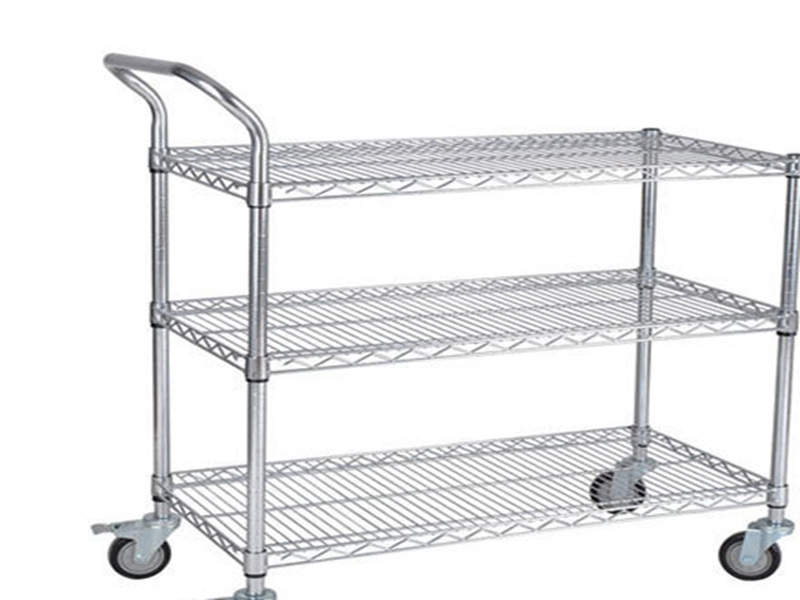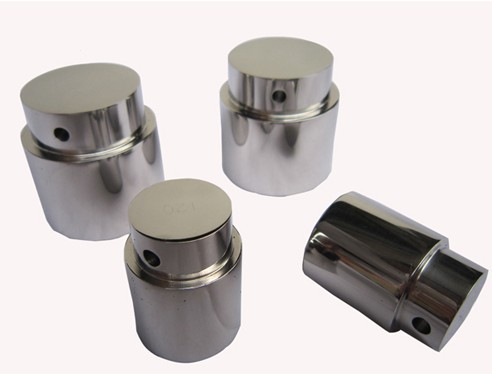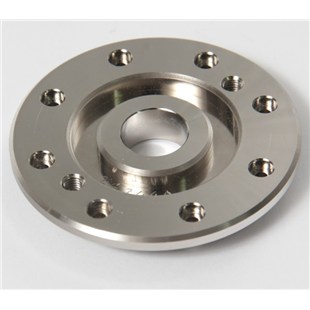Chromium is a kind of micro-band blue silver-white metal. Modern technology research has found that its relative atomic mass is 51.99, density is 6.98~7.21g/cm3, melting point is 1875~1920°C, and standard electrode potential is Yush/c,-0.74. V, old "/c," -0.41V and P even e+/Cr shake -1.33V, metal chromium is easily passivated in the air, forming a very thin passivation film on the surface, thus showing the properties of precious metals.
The chrome layer has a high hardness, and the hardness can vary within a wide range of 400 to 1200 HV depending on the composition of the bath and the process conditions. The chrome-plated layer has good heat resistance. When it is heated below 500 °C, its gloss and hardness do not change significantly. When the temperature is higher than 500 °C, oxidative discoloration begins, and the hardness of more than 700 °C begins to decrease. The friction coefficient of the chrome layer is small, especially the dry friction coefficient, which is the lowest among all metals. Therefore, the chrome plating layer has good wear resistance.
The chrome plating layer has good chemical stability and does not function in alkali, sulfide, nitric acid and most organic acids, but is soluble in hydrochloric acid (such as hydrochloric acid) and hot sulfuric acid.
In the visible range, chromium has a reflectivity of about 65%, between silver (88%) and nickel (55%), and because chromium does not change color, it can maintain its reflective ability for a long time and is superior to silver and nickel. .

Classification
Due to its excellent properties, the chrome layer is widely used as an outer layer and a functional coating for protecting a decorative coating system, and has always played an important role in the electroplating industry. With the development of science and technology and people's increasing emphasis on environmental protection, microcracks and microporous chrome, black chrome, loose pore chrome, low concentration chrome plating, high efficiency hard chrome plating, and trivalent have been developed on the basis of traditional chrome plating. New processes such as chrome plating and rare earth chrome plating have further expanded the application range of chrome plating.
The chrome plating bath can be classified into the following types depending on the composition and performance of the chrome plating solution.
1. Ordinary chrome plating solution A chrome plating solution using sulfate as a catalyst. The plating solution contains only chromic anhydride and sulfuric acid, and has simple composition and convenient use. It is currently the most widely used chrome plating solution. The ratio of chromic anhydride to sulfuric acid is generally controlled at Cr03:H2SO4=100:1, and the concentration of chromic anhydride varies from 150 to 450 g/L. According to the concentration of chromic anhydride, it can be divided into high concentration (350~500g/L), medium concentration (150~250g/L) and low concentration (50~150g/L) chrome plating solution. It is customary to refer to Cr03250g/L and H2SO42.5g/L medium-concentration chrome plating as "standard chrome plating", also known as "universal chrome plating", for decorative and functional chrome plating. The low concentration of chrome plating liquid has high current efficiency, and the chromium layer has high hardness, but the covering ability is poor. It is mainly used for functional plating, such as hard chrome plating, wear-resistant chrome, etc.; high concentration plating solution is stable, good conductivity, electrolysis Only a lower voltage is required, the coverage is better than the dilute solution, but the current efficiency is low, mainly used for decorative chrome plating and chrome plating of complex parts.
2. Composite chrome plating solution chrome plating solution using sulfuric acid and fluorosilicic acid as catalysts. The addition of fluorosilicic acid improves the current efficiency, coverage and brightness range of the plating solution compared with ordinary chrome plating solution. For example, the current efficiency of the cathode can reach more than 20%. However, fluorosilicic acid has strong corrosive effect on the parts where the anode and cathode parts are not plated with chrome and the lead lining of the plating tank, and certain protective measures must be taken. The lining and anode are preferably made of lead-tin alloy. This bath is mainly used for barrel chrome plating.
3. Automatic adjustment of chrome plating solution Chrome plating solution using barium sulfate and potassium fluorosilicate as catalyst. In a certain temperature and a certain concentration of chromic acid solution, barium sulfate and potassium fluorosilicate each have a precipitation and dissolution equilibrium, and respectively have a solubility product constant Ksp, that is, when the concentration of [S042-] or [SiF62-] in the solution increases. When large, the corresponding ion concentration product will be larger than the solubility product constant, and excess S042- or SiF62- will precipitate with SrS04 or K2SiF6 precipitate; on the contrary, when the concentration of [S042-] or [SiF62-] in the solution is insufficient, the groove The precipitate of SrS04 or K2SiF6 is dissolved until the corresponding ion concentration product is equal to its solubility product. Therefore, when the temperature of the plating solution and the concentration of chromic anhydride are constant, the concentration of [S042-] or [SiF62-] in the plating solution can be automatically adjusted by dissolving the precipitation balance, and does not change with the continuation of the plating process. These baths have high current efficiency (270A), allow a wide range of current densities (up to 80~100A/dm2), good dispersion and coverage of the bath, and fast deposition speed (50/-m/h). Therefore, it is also called "high-speed automatic adjustment chrome plating". However, the plating solution is highly corrosive.
4. Fast chrome plating on the basis of ordinary chrome plating, adding boric acid and magnesium oxide, allowing the use of higher current density, thereby increasing the deposition speed, the resulting coating has a small internal stress and good adhesion to the substrate.
5. Tetrachromate chrome plating solution has a high concentration of chromic anhydride. In addition to chromic anhydride and sulfuric acid, the plating solution also contains sodium hydroxide and sodium fluoride to enhance cathodic polarization. Sugar or alcohol is added as a reducing agent to stabilize Crs+ in the plating solution; sodium citrate is added to mask iron ions. The main advantage of this type of bath is high current efficiency (more than 35%), fast deposition rate,
The dispersing ability of the plating solution is good, but the plating solution is stable only at room temperature, the operating temperature should not exceed 24 ° C, and the plating solution needs to be cooled when high current density is used; the plating layer has poor brightness, low hardness, and needs to be polished after plating to meet the decoration. Chromium requirements.
6. Normal temperature chrome plating bath consists of chromic anhydride and fluoride (NH4F or NaF), and a small amount of sulfuric acid can also be added. The bath has a low operating temperature (15~25°C) and a current density (8~12A/dm2), and the deposition rate is slow, which is suitable for thin layer plating. Its high current efficiency and dispersion ability can be used for rack plating and barrel plating.
7. The concentration of chromic anhydride in the low concentration chromic acid chrome plating bath is 5 times lower than that of the standard chrome plating solution, which can greatly reduce the environmental pollution. The current efficiency and hardness of the coating are between standard chrome plating and composite chrome plating. The coverage and corrosion resistance are comparable to high concentration chrome plating. However, the plating solution has a large electric resistance and a high tank voltage, and the rectifying equipment is required to be strict, and the covering ability of the plating liquid needs to be improved.
8. In the trivalent chromium chrome plating bath, a Cr3+ compound is used as a main salt, and a complexing agent, a conductive salt and an additive are added. The process eliminates or reduces environmental pollution, the dispersing ability and covering ability of the plating solution is higher than that of the chromic acid plating solution, and the cathode current efficiency is improved; the plating can be performed at room temperature; the groove pressure is low; the plating is not affected by the current interruption. However, the plating solution is sensitive to impurities, the gloss of the coating is dark, the thickness of the coating is several micrometers, and it cannot be thickened at will; the hardness of the coating is low, and the composition of the plating solution is complicated, which is not conducive to maintenance.
9. Rare earth chrome plating solution adds a certain amount of rare earth elements and fluoride ions to the traditional chrome plating solution. The use of rare earth elements can reduce the concentration of chromic anhydride, broaden the plating temperature range (10~50 °C) and the cathode current density range (5~30A/dm2), reduce the groove pressure, and improve the brightness and hardness of the coating. The chrome production achieves low temperature, low energy consumption, low pollution and high efficiency, so-called "three low and one high" chrome plating process. However, there are still different views on the stability and reliability of the plating solution, especially the research on its mechanism remains to be further studied.

Main Features:
Compared with other single metal plating solutions, the chrome plating solution is simple in composition, but the chrome plating process is quite complicated and has the following characteristics.
1. The main component of the chrome plating solution is not the metal chromium salt, but the chromic acid, chromic acid, which is a strong acid plating solution. In the electroplating process, the cathode process is complicated, and the cathode current is mostly consumed in the two side reactions of hydrogen evolution and hexavalent chromium reduction to trivalent chromium, so the cathode current efficiency of chrome plating is very low (10%~l8%). Moreover, there are three anomalies: the current efficiency decreases with increasing chromic anhydride concentration, l decreases with increasing temperature, and increases with increasing current density.
2. In the chrome plating solution, a certain amount of anions, such as SO42-, SiF62, F, etc., must be added to achieve the normal deposition of metallic chromium.
3. The chrome plating solution has a low dispersing ability. For complex shapes, a pictographic anode or an auxiliary cathode is required to obtain a uniform chrome plating layer. The requirements for the hangers are also strict.
4. Chrome plating requires a higher cathode current density, usually above 20A/dm2, which is more than 10 times higher than the general plating. Since the cathode and the anode deposit a large amount of gas, the resistance of the plating solution is large, the cell pressure is increased, and the plating power source is required to be high, and a power source larger than 12V is required, and other plating materials can be used with a power source of 8V or less.
5. Chrome-plated anodes do not use metallic chromium, but use insoluble anodes. Lead, lead-bismuth alloys and lead-tin alloys are commonly used. Chromium consumed in the bath due to deposition or other reasons is supplemented by the addition of chromic anhydride.
6. Chrome-plated operating temperature and cathode current density have a certain dependence, changing the relationship between the two can obtain different properties of chrome plating.
Type and Purpose
There are many types of chrome plating, which can be classified as follows according to their use.
1. Protective one decorative chrome protection A decorative chrome is commonly known as decorative chrome, the coating is thin, bright and beautiful, usually as a multi-layer
For the purpose of protection, the outermost layer of the plating must be plated with a sufficiently thick intermediate layer on the zinc-based or steel substrate and then plated with a thin layer of chromium of 0.25-0.5 μm on the bright intermediate layer. Commonly used processes are Cu/Ni/Cr, Ni/Cu/Ni/Cr, Cu-Sn/Cr, and the like. After the surface of the polished product is chrome-plated, a silver-blue mirror gloss can be obtained. It does not change color in the atmosphere for a long time. This kind of coating is widely used in the protection and decoration of parts such as automobiles, bicycles, sewing machines, watches, instruments, and daily hardware. The polished decorative chrome layer provides high reflectivity to light and can be used as a mirror.
Plating microporous or microcracked chromium on multi-layer nickel is an important way to reduce the total thickness of the coating and obtain a high corrosion resistance protection system. It is also the development direction of modern electroplating process.
2. Hard chrome plating (wear-resistant chrome) The coating has high hardness and wear resistance, which can prolong the service life of the workpiece, such as cutting and drawing tools, pressing dies and molds of various materials, bearings, shafts, gauges, gears, etc. It can also be used to repair dimensional tolerances of worn parts. The thickness of hard chrome plating is generally 5~50μm, which can also be determined according to needs, and some are as high as 200~800μm. Hard chromium plating on steel parts does not require intermediate plating. For special corrosion resistance, different intermediate coatings are also available.
3. The white chrome-plated chrome layer is milky white, with low gloss, good toughness, low porosity, soft color, low hardness compared with hard chrome and decorative chrome, but high corrosion resistance, so it is often used in measuring tools and instrument panels. In order to improve the hardness, the surface of the milky white coating can be further coated with a layer of hard chrome, which is called double chrome plating, which has the characteristics of white chrome plating and hard chrome plating. It is mostly used for plating, which requires wear resistance and corrosion resistance. Components.
4. Plated hole chrome (porous chrome) is characterized by the use of chrome layer itself with fine cracks. After hard chrome plating, mechanical, chemical or electrochemical loose hole treatment is carried out to further deepen and widen the crack network. The surface of the chrome layer is covered with a wide groove, which not only has the characteristics of wear-resistant chrome, but also can effectively store the lubricating medium, prevent the lubrication from running, and improve the anti-friction and wear resistance of the workpiece surface. It is commonly used for the plating of the surface of a heavy-duty sliding friction member, such as the inner cylinder of a cylinder barrel of an internal combustion engine, a piston ring, and the like.
5. Black chrome black chrome plating black color with uniform gloss, good decorative, good matting; high hardness (130~350HV), wear resistance is 2~3 times higher than bright nickel at the same thickness; Corrosion is the same as ordinary chrome plating, mainly depending on the thickness of the intermediate layer. Good heat resistance, no discoloration below 300 °C. The black chrome layer can be directly plated on the surface of iron, copper, nickel and stainless steel. For the purpose of improving corrosion resistance and decoration, copper, nickel or copper-tin alloy can also be used as the bottom layer, and black chrome plating is applied on the surface. Black chrome plating is often used to protect the components and components of aviation instruments and optical instruments, solar absorbing panels and daily necessities.


